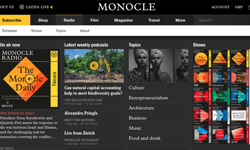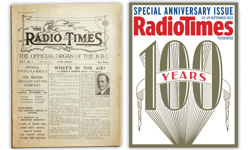Up two flights of steep, narrow stairs into the eaves of a historic looking building in Stalbridge High Street lies the heart of an astonishing publishing success story.
Stalbridge is a small town (pop: 2,719) in the north of North Dorset with a traffic problem – bus + dustcart on narrow street = trouble – on the road to nowhere in particular. And it's this unique geography, nestling on the edge of the Blackmore Vale where Dorset meets Somerset and Wiltshire that helps make it so special.
It's a community that does not sit easily in local government administrative areas, transport links or even the phone book - but it's all brought together in the pages of the Blackmore Vale Magazine.
This weekly "bible for the local community" - according to editor Tim Lethaby - runs up to 172 pages and features everything from Antiques & Collectibles through to Wedding Services via Food & Drink and Pets.
The A4 magazine is clear, easy to read and well put together. It takes just seconds to find a chimney sweep, see where to go for Open Farm Sunday and cast envious eyes over the 45 pages of largely beautiful, and surprisingly affordable properties for sale.
Tim and his editorial staff (pictured) put together the content for the magazine's two editions that are available free in a myriad of pick-up points and on sale for £1 in traditional outlets, with a total print run of 85,000.
"We focus on the positives in the community," says Tim, who himself has a background in local newspapers. "We are here to support what goes on in the nearby towns and villages."
With what Tim calls a "sympathetic pricing structure", local businesses are able to advertise directly to a local community in a way that is far more affordable, and targeted, than in more traditional media, especially local weekly and regional newspapers.
The Blackmore Vale Magazine is one of hundreds - maybe even thousands - of local, community publications that are thriving. From two page newsletters to well-designed newspapers and full colour glossy, perfect bound magazines, they abound in communities from the rural to the urban.
It's difficult not to feel they are doing what local newspapers used to do before the dash for digital and economies forced by the migration of advertising led to a change of direction.
With some sort of delicious irony, the Blackmore Vale Magazine is now owned by Local World (née Northcliffe) which also publishes nearby weekly, the Western Gazette, from Yeovil and the regional daily, Western Daily Press.
Strike was lucky break
Just around the corner from the office in Stalbridge live Alan and Ingrid Chalcraft, who took on the Blackmore Vale Magazine when it was a struggling straggler – just four A4 sheets – and turned it into the vibrant publication it is today.
Fed up with living and working in London, the Chalcrafts moved to this corner of the countryside and bought the rights to the publication for £5,000.
“We went out on a limb to see what would happen,” recalls Alan. “We never had anybody selling advertising. It just came in.”
The Chalcraft’s lucky break came in the shape of industrial action which hit the traditional media. “The estate agents and the county councils still needed to get their message out so they came to us. And the even bigger surprise was that they never left.”
And all this produced from their home by Alan and his wife Ingrid: “I was the editor and she did the important thing – making sure the money came in.” But as the magazine prospered, office premises were acquired plus a graphic artist who helped take the magazine to a different level. And that success attracted the attention of the established media groups who wanted a slice of the action.
The Chalcrafts eventually sold out to Trinity Mirror in 1993 for more than £1 million. “It needed the financial input and we just decided one day to take the offer and move on,” says Alan, now 73, and as interested in local media as ever. As we ended our interview, he pointed me towards Hole and Corner magazine, which I find ‘celebrates craft, beauty, passion and skill’.
The visitor calls in
In an area where traditional local media struggle, there are at least three other thriving magazines. Valley News is another 100-plus page A4 newsprint magazine serving South Wiltshire and North Dorset, The Conduit Magazine has been going for eleven years covering the West Dorset and South Somerset border area and The Visitor is an “informative and lively free magazine” covering Somerset, North Dorset and parts of Wiltshire.
Whilst being called The Visitor, the magazine is not aimed at visitors to the area.
The name is taken from the original Castle Cary Visitor - Eight pages of small print priced at one penny, published between January 1896 and December 1915 - which was founded and edited by William Macmillan (1844-1911), family forerunner of Macmillan Cancer Support.
The Visitor is now owned and run by Helen Dunion who took it over with her husband in 1983 and has run it on her own since his death in 1991. “We didn’t have any financial backing when we started,” recalls Helen, “but we thought about it carefully and decided ‘we can make some money out of this’.”
Now more than 30 years later, the magazine has a circulation of 29,000 and ‘hundreds of outlets’ from newsagents, pubs, libraries and some targeted door-to-door.
“Sometimes you feel you are on a wheel with one issue finishing and another starting, but that’s the nature of the business,” she says, when asked what advice she may have for entrepreneurs wishing to get into this field.
Don't ignore print
Just 60 miles north, but feeling a lifetime away, lies Filton on the outskirts of Bristol.
Richard Coulter, a former assistant editor of the Bristol Post, started up the monthly filtonvoice three years ago and is now reaping the rewards of his ‘print-first’ model. “Don’t ignore print just because it’s fashionable to go digital. The audience for print is reliable and advertisers love it,” says Richard.
With the Bristol Post selling fewer than 30,000 paid copies across the whole of the Bristol conurbation and the filtonvoice delivering 50,000 copies directly into letterboxes in one discrete area, it’s not difficult to see the attraction. Put that home delivery alongside copies stashed in hairdressers, supermarkets and even McDonalds and it’s difficult for residents not to see a copy.
“In every edition, most people should find somebody they know and something they are interested in,” says Richard, who is proud to call filtonvoice “very much a community thing”.
And his advice to would-be entrepreneurs? “Too many people come into this who haven’t thought it through as a business. It’s not just a journalistic plaything. Do your homework and make sure it will make sense financially.”
Top Tips for Community Entrepreneurs
* Get the distribution right: It’s no good having the best publication imaginable if no-one is able to read it. There is every combination available from paid-for to pick-up or door-to-door. Just work out what is best for you.
* Ensure you are the go-to place for information: What is more useful? Finding out what happened at the last council meeting or knowing when the recycling will next be collected? I won’t venture a response, but it’s important to establish your publication as useful, relevant and up-to-date.
* Forget traditional journalism: Some publications have journalists who rewrite what gets sent in, some print it as they receive it and others don’t have any editorial at all, relying on the ads to serve as the content. Decide what works best for you, but think carefully before investing in expensive, trained journalists.
* Price advertising affordably: Traditional local newspapers have dug themselves quite a big hole that is proving difficult to scramble out of. Their pricing structure, designed to capture the agency media buyer, does little to attract the small-budget customer. Enter the community magazines to deliver the right size and shape of advertising to the right people at the right price.
* Get your business head on: Owning a publishing business, like running football clubs, attracts the wrong people doing the wrong things for the wrong reasons. Get an accountant, or at least keep a close eye on the ins and outs… or you'll be out for good.
* Be clever with digital: Most of the magazines have a digital presence, which are most often used to post more photos than can be used in the magazine and deliver ‘breaking news’, such as road accidents or weather-related stories.
* Stay local: Local is a banned word in many, er, local newspaper newsrooms. It is meaningless unless attached to a defined area. So work out what you mean by local. Ask how far you would travel for a family day out or a celebration meal and you probably won’t be far off.
* Have fun!
Footnote: Been there, done that…
Back in the early '80s, I saw a gap for a community newspaper in the Norfolk village where I lived. So I wrote and designed copies of an 8-page newspaper, had it printed up the road and distributed door-to-door in my daughter's doll's pram. But I did it for all the wrong reasons (see top tips); I loved writing and putting publications together and saw entrepreneurs getting rich quick. It folded after two issues.
Never one to be knocked back, I tried again, this time with an adman friend who had his head screwed on. We ditched my golden words, concentrated on his paid-for advertising, sorted a proper distribution network and produced a community publication that lasted 30 years.












